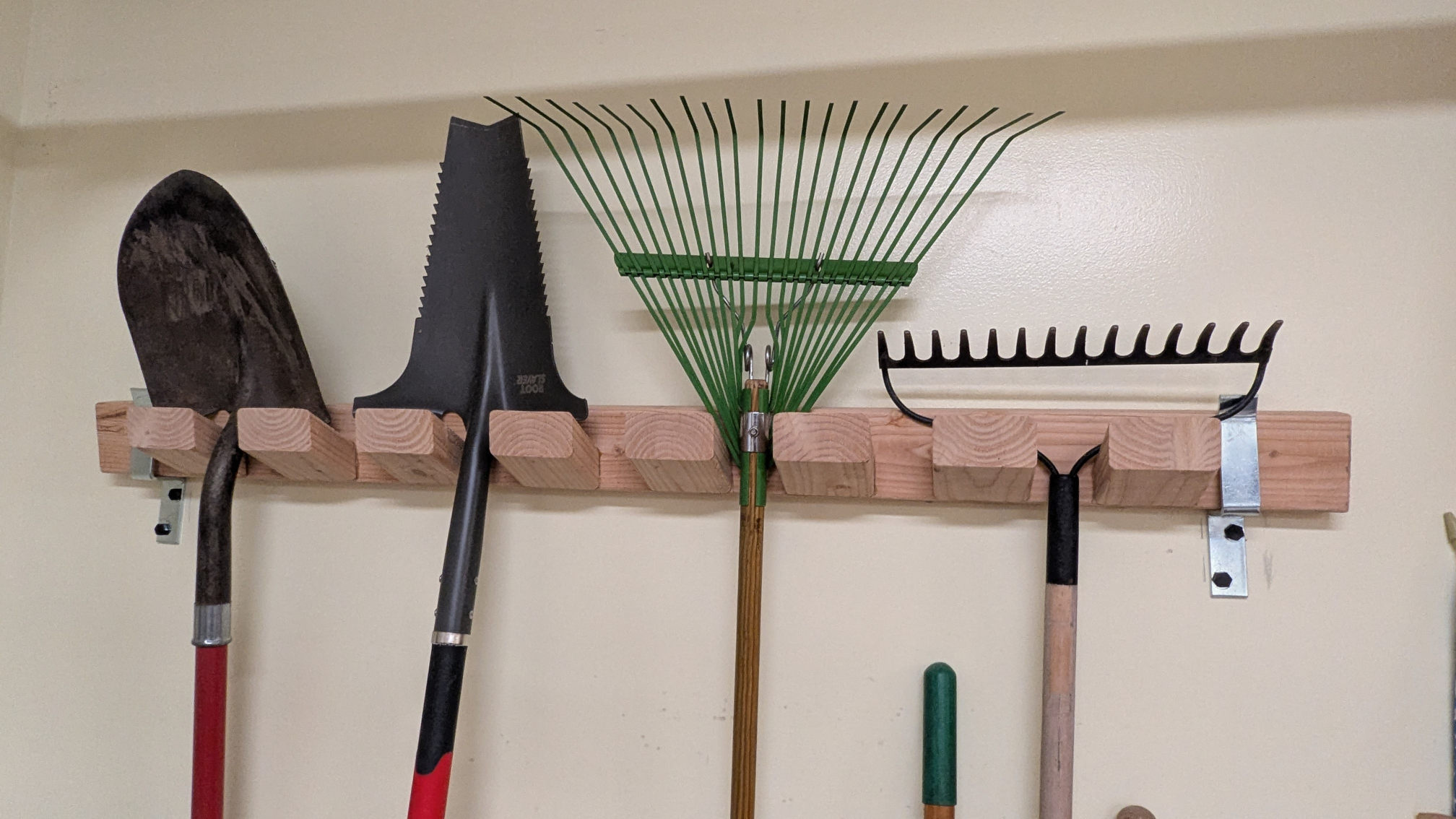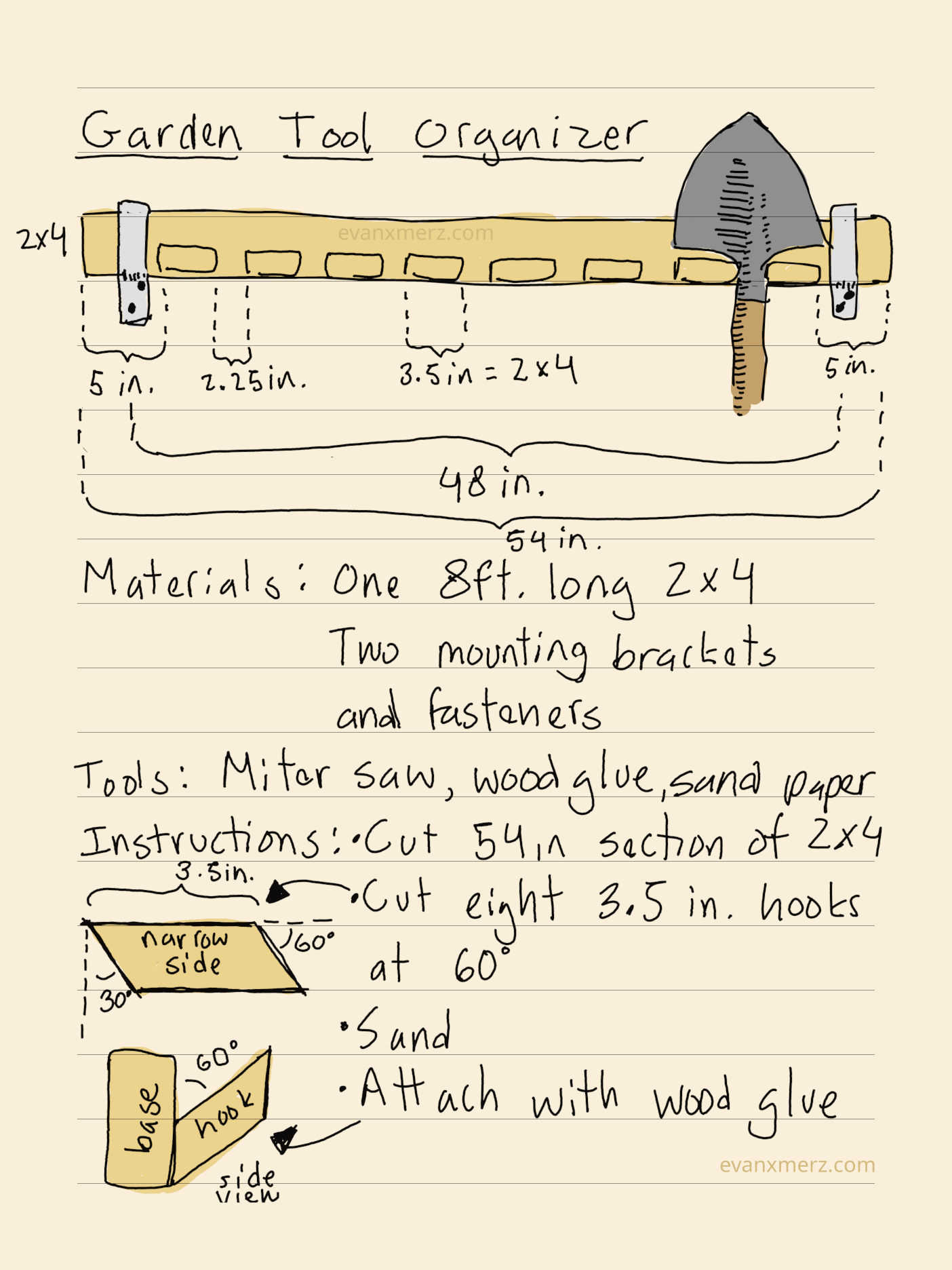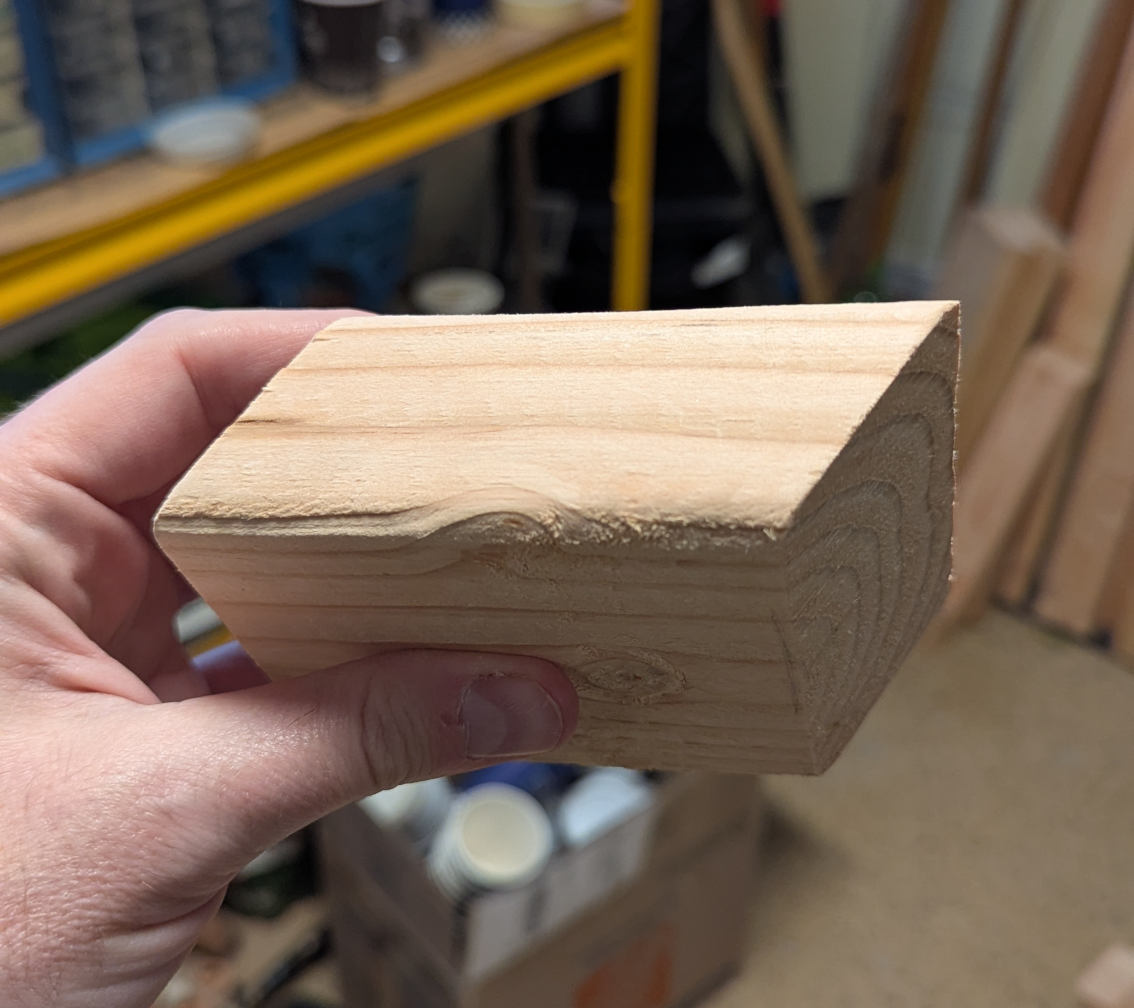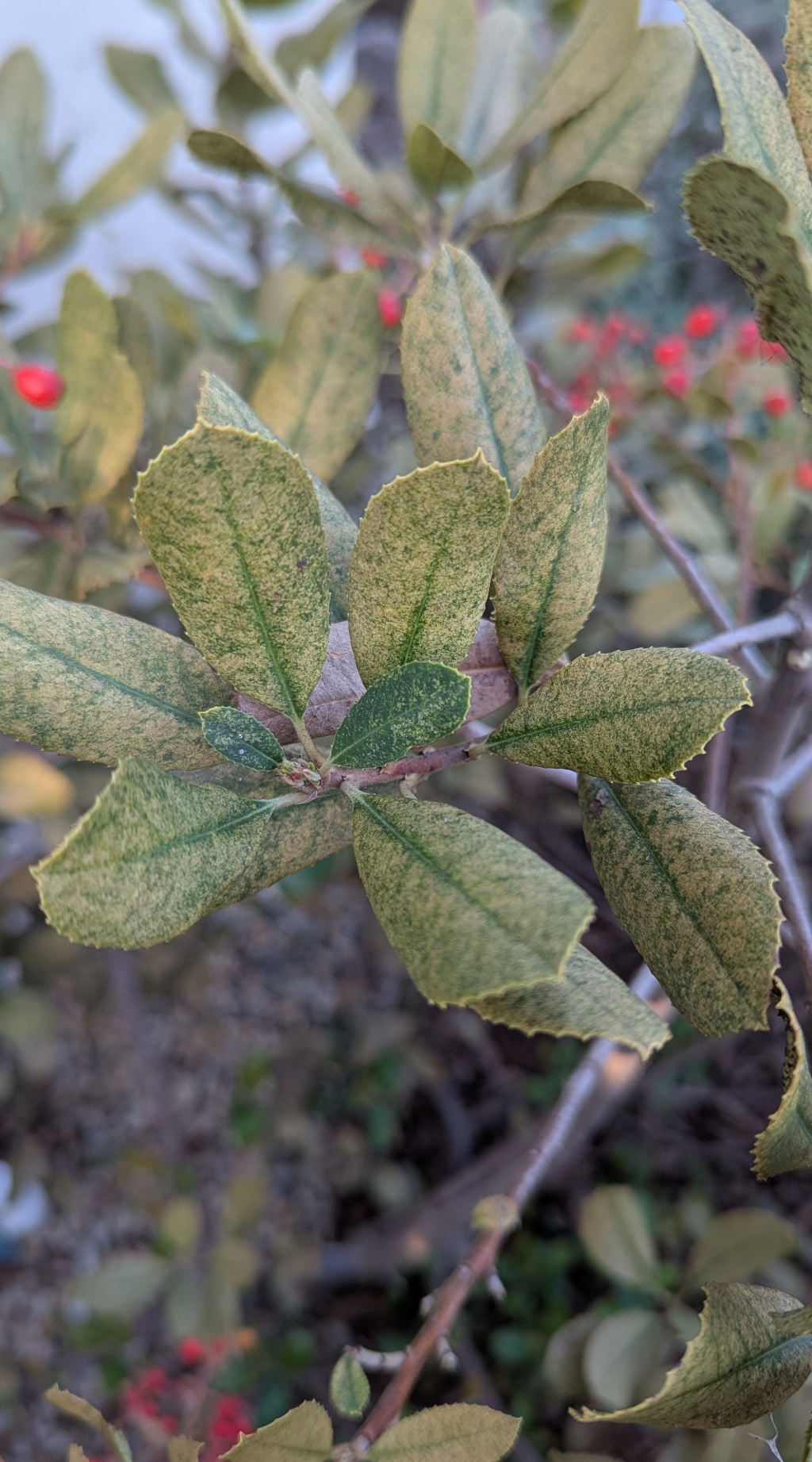How to make a garden tool rack from one 2x4
I recently noticed that my garage was getting a bit messy. I needed a way to hang some of my garden tools on the wall to keep them out of the way when not in use. I also wanted to make something from scratch in order to keep learning the basics of wood working that are useful for gardeners.
So I searched the internet for a simple garden tool rack and I found a few good ideas, but none that I really loved. They all looked a bit cheap or they required a lot of lumber.
I've seen the price of lumber, so I wanted to keep this build small. In fact, I wanted to build the entire thing out of a single eight foot long 2x4.
I scratched out a design, built it in one day, and I thought the result was good enough to share.

So without further ado, here is my design for a simple garden tool rack that can be made from a single 2x4.
Simple garden tool rack plans

One thing to notice is that the rack itself is made from a single 2x4, however, attaching it to the wall requires some additional materials. There are many ways to attach it to the wall. I chose to use a couple of open brackets that I found at home depot.
The only tools I used to make the rack were a miter saw, a tape measure, and some wood glue. I also used a stud finder, a drill, and a wrench in order to hang it on the wall.
Steps for building a garden tool rack from a single 2x4
The first note about this is that the length I chose was based on the distance between the studs in my wall. I found two good studs that were 4 feet (48 inches) apart, so I built a rack that was 54 inches long to allow space for the brackets. If your studs are spaced differently, then you may have to tweak the length of the base.
Also notice how the hooks are spaced and angled up. I cut them at a 60 degree angle to get them to point upward slightly. I spaced them 2.25 inches apart in order to be able to hold about any garden tool and to fill the entire available space.

Finally, I assembled this using only wood glue just to keep it simple. If you have particularly heavy tools, or you want to make a sturdier rack, then you may want to secure each hook using a screw or two from the back.
Here are the steps I used:
- Make the base. Cut one length of 2x4 to 54 inches.
- Make the hooks. Adjust your miter saw to an angle of 60 degrees and cut eight lengths of 2x4 at 3.5 inches each.
- Sand each of the hooks.
- Measure five inches from one end of the base. Place a hook on the base at that location and trace around it so that you know where it will go.
- Measure 2.25 inches from the end of the first hook and trace another hook at that location.
- Continue until you've marked the location of each hook.
- Apply wood glue to the bottom of each hook and attach them to the base.
- Wait 24 hours for the glue to dry.
Clamping this up can be a bit tricky, so you might have to be creative with what you have. Just remember that most garden tools aren't very heavy, so it will probably work just fine even if you don't bother with clamps at all.
Lace bugs: The overlooked garden pests
One day this summer when I was watering the younger plants in my native front yard, I noticed some surprising damage on my Toyon bush. Some of the leaves were spotty and discolored. In fact, a lot of the leaves were damaged this way. So many were damaged that the plant was actually losing leaves in the middle of summer (although this picture of the damage was taken in the subsequent fall).

At first I assumed that the plant was just struggling a bit and I gave it a little more water, but when the plant didn't recover in a few weeks, I knew that something more serious was going on.
That's when I investigated for pests, and they were easy to find. The first damaged leaf that I turned over showed me some insects that I had never seen before.

Like most people discovering an insect infestation, I was pretty frightened at first. Especially since I didn't recognize the pest at all.
So I started searching the internet to identify the culprit. I searched for Toyon pest insects, and for sucking insects of California natives, but all I found was the usual suspects. The internet showed me aphids, thrips, and scale, but I knew it wasn't any of those.
I finally turned to an app for identification. I don't remember exactly which app I used as I no longer have it on my phone, but it came up with the identification right away: lace bugs.
As a UC Master Gardener, I had seen most of the common garden pests, so I was curious about how this one had escaped me. It never came up in any of my training, and I've never heard anyone complain about damage from lace bugs. In fact, many people tend to think of the common garden predators lacewings whenever lace bugs are brought up.
It turns out that lace bugs are common garden pests all over the world. They are host-specific sucking insects, which means that each species of lace bug lives off of one species of plant. They put their mouth parts into the underside of the leaves and suck the sap out of the plant.
According to wikipedia, they are most easily identified by their enormous and elaborate wings.
They have 2 sets of wings; a pair of forewings and pronotum wings, which vary in size between individuals, typically having reduced forewings and larger pronotum wings. Despite their apparent beauty, the wings are highly decorative and adults are poor fliers, carrying out their sedentary lifestyle on leaves and the shoots of plants.
The reason that lace bugs are overlooked is that, even with severe infestations such as mine, they typically don't kill a plant. They might make it look a little rough for awhile, but, according to the internet, eventually the local predators will catch up to them and keep them in check.
Unfortunately, despite them being right next to my milkweed that is covered in ladybugs, the local predators don't seem to enjoy eating my lace bugs. So my Toyon lost nearly all its leaves this year and looked quite bare.
As for control measures, I'm now cleaning up the fallen leaves to prevent them from overwintering in the leaf litter. I'm also manually picking them off the plant, but it's impossible to pick them off of every leaf.
So for now I'm hoping to share my experience with you and spread the word about these overlooked garden pests. Hopefully the predators in my yard will catch up to them in 2026.
A review of the Supernote Nomad after three months
For all my life I've enjoyed writing notes by hand. I liked taking notes in school, and I like taking notes at work. It helps me remember what we talk about, and gives me a reference point when coming back to something after a break.
However, I have a collection of literally hundreds of notebooks in my attic. I have every notebook I've written since university, and a few from high school.
I don't know exactly why I keep them. I only ever revisit them for two reasons. When I'm updating my resume I sometimes review them to remember what I was doing in a particular year. And occasionally I like to pull out a piece of music that I wrote years ago and dust it off on the piano.
But I don't like waste.
And I was struggling with another issue, too: I was too addicted to streaming services. My Galaxy tablet made it too easy to watch Netflix, and the reading experience was terrible.
So when I heard about the Supernote Nomad, I decided to take the plunge. At this point I've owned it for around three months, and I want to share my thoughts about it with the internet.
Features of the Supernote Nomad
I was drawn to the Supernote Nomad for a few specific reasons.
- Size. It's about the size of the small notebooks that I prefer to use. It's small enough that I can easily carry it in one hand with my laptop while I have a coffee in my other hand.
- Doodling. The Supernote tablets are among a number of recent tablets that allow the user to write notes out by hand. They also allow me to doodle in the margins, which is my favorite activity in long, boring meetings.
- Export. The Supernote Nomad offers the ability to export not only to pdf, but also to image formats. Weirdly I couldn't find this feature on the Amazon Kindle Scribe.
The good, the bad, and the ugly
After using it for a few months, I can verify that my reasons for choosing it were justified. The drawing and note-taking experience is generally very similar to writing with a pen. The tablet allows me to export to image formats and share them to Dropbox very easily. And the size is nicely compact as well.
But the size isn't quite perfect. I like to write on lined paper, and the smallest lines offered by the system only allow for 17 lines of text to be written on one page. So I could fit much more text on one page if the lines were just a little closer together.
The battery life is great. Like similar e-ink tablets, the battery lasts long enough that I forget to charge it. I typically charge once a week.
The reading experience is also great. It's very similar to the old Kindle e-ink tablets that I loved reading on before Amazon introduced the Kindle Fire, and generally spoiled the experience by trying to do too many things.
One thing that I don't like so much is that the display does that e-ink thing where it needs to be refreshed every few pages. The prior pages sort of remain lightly on the screen in the background, and this can build up and become distracting until you swipe to refresh the screen.

Another small nitpick is that the pen sometimes seems to write when it isn't touching the screen. This requires the user to re-calibrate the pen, which is easy enough, but sort of annoying.
And my final complaint is that the carrying case is entirely necessary. The device shouldn't be sold without it. I first bought it alone and figured that I would get a third party case, but this makes the experience of turning it off and on rather awkward. The normal way to turn it off and on is to use magnets in the first party case. This essentially makes it function like any other notebook. So if you're considering buying one, just know that you should factor in the cost of the first party case.
Otherwise I'm very happy with it. I'm not going to give it a numerical score, but I will simply say that I'm glad I decided to purchase it.
I like slow tech
The thing I like most about the Supernote Nomad is that the design pushes me into things I want to do with tech, rather than the things that exist to give me cheap hits of dopamine. The Supernote Nomad basically allows me to read a book, take notes, or do some sketching. There's no streaming services or videogames. There's no web browser or social media. There's no text messaging.
It's slow tech that is designed for humans.
The Supernote Nomad is a human friendly device in a way that standard tablets just aren't.
I hope that larger tech companies take notice of the Supernote tablets. I want to see more devices that work at human speed rather than as fast as possible. I want to see more devices that feel comfortable and well designed.
So if you're looking for a piece of tech that feels like it isn't forcing you to be constantly connected and constantly consuming, then I encourage you to consider it.
Are dynamic accumulators a garden myth?
I was listening to episode 444 of the excellent Joe Gardener Show when the guest brought up so-called dynamic accumulators. She mentioned them in the context of permaculture, and repeated the conventional wisdom about using tap rooted plants such as comfrey to pull nutrients up from deep in the soil.
The guest was Brandy Hall from Shades of Green Permaculture. Here's what she said.
Dynamic accumulation. That's a term that's really popular in permaculture. Deep taprooted plants that pull nutrients up, assuming the nutrients are in the soil. You know they aren't pulling them from thin air. Pulling what's there up into their leaves. Those leaves die in the winter and then those nutrients are released into the upper horizons of the soil.
It's hard for me to hear about dynamic accumulators from experts because to me, dynamic accumulators seem like the gardening equivalent of bigfoot. They are much talked about, but when you try to examine them, they disappear.
The concept of dynamic accumulators feels a little thin to me, so in this blog post I'm going to try to pin them down and see what sticks.
Defining dynamic accumulators is hard
The big problem with dynamic accumulators is that they have no scientific definition. Some people say that they are plants that pull nutrients from the soil and store them in the leaves. Other people tie the concept to tap roots. They say that dynamic accumulators pull nutrients from deep in the soil and bring them to the surface.
Unfortunately, these ideas are both flawed to my understanding.
All plants pull nutrients from the soil and move them into their bodies. That's basically the definition of a plant. Plants use sunlight to combine water with nutrients in the soil to make sugars and other nutrients that they store in their bodies and give away in the soil food web. Every single plant does this, so the concept is meaningless as a distinction.
And the idea that tap roots pull nutrients up from deep in the soil doesn't make much sense to me either. The vast majority of nutrients in the soil are in the top few layers of soil. The nutrients are in the organic matter in the humus and the topsoil.
It makes no evolutionary sense for a plant to send a deep tap root into the soil with the fewest nutrients. It would be much better off sending fibrous roots into the top few layers of soil.

So if dynamic accumulators don't stand up to my own critical thinking, how are they being discussed by professionals and scientists?
What does science say about dynamic accumulators?
The best overview of the topic of dynamic accumulators that I've found is Breaking Ground with Dynamic Accumulators by Greta Zarro. She points out that practically everything we think we know about dynamic accumulators is indeed anecdotal. It's not based on evidence.
But she also points out that this is beginning to change in some interesting ways.
For instance, there's an effort to pin down a scientific definition of what qualifies as a dynamic accumulator in reference to existing classifications of plants that remove specific things from soil.
While dynamic accumulators are used to gather beneficial nutrients from the soil, hyperaccumulators are used to gather toxic heavy metals. When used for soil remediation, the plant tissue of hyperaccumulators is harvested and removed from the site. To qualify as a hyperaccumulator, a plant must accumulate metals above established threshold concentrations: 100ppm (for Cd), 1,000ppm (for Co, Cu, Ni, As, and Se), and 10,000ppm (for Zn and Mn). Brown suggests that similar thresholds should be set for dynamic accumulators, in ppm, using dried plant tissue samples, consistent with hyperaccumulator thresholds.
She points to work by Brown and Kourik that goes even further.
Kourik suggested that dynamic accumulators should demonstrate high amounts of nutrient accumulation, as compared to other plants. To address this, we started by setting the thresholds at 200% of nutrient value averages, which results in about 10.40% of plants qualifying in each nutrient category. However, for this model to endure, the thresholds need to be fixed at specific values rather than remain relative to the averages, because those averages will change over time as new plants are added to the databases. So we rounded off the thresholds and set them at even numbers, still roughly 200% of the averages, representing the top 10.08% of plants.
And since that article is from 2020, we can now look at the results of the author's two year study of dynamic accumulators.
Unfortunately, the results aren't quite clear. While it's true that some of the plants they studied were indeed able to accumulate higher concentrations of some nutrients, these levels were almost always in proportion to what was already in the soil. It was very rare that plants were able to accumulate high levels of specific nutrients in poor soil.
Perhaps most importantly, we found that plant tissue nutrient concentrations are relative to soil nutrient concentrations. Dynamic accumulators are well-suited to extract specific nutrients from fertile soil, but they aren’t going to create nutrition that isn’t there...That said, even when grown in poor, unamended soil, two species surpassed dynamic accumulator thresholds. Dried lambsquarters foliage was found to possess potassium concentrations that exceeded dynamic accumulator thresholds (40,715 ppm), and liquid fertilizer made by steeping lambsquarters foliage in water for 5 days contained the highest potassium concentrations of all the trial crops (903 ppm)... Likewise, Russian comfrey foliage surpassed dynamic accumulator threshold concentrations for both potassium (52,959 ppm) and silicon (513 ppm), with similarly high potassium concentrations found in the resulting liquid fertilizer (889 ppm).
They also found that stinging nettle made particularly good fertilizer, both in a liquid form, and when chopped and dropped directly onto the soil.
We found stinging nettle foliage to possess the highest calcium concentration of all trial crops... Liquid fertilizer derived from stinging nettle foliage proved to be very nutrient rich, possessing the highest concentrations of P, B, Ca, Cu, and Mn after 5 days of steeping compared to all other trial crops, as well as the highest nutrient carryover rates for all of these nutrients plus K and Mg, meaning stinging nettle’s nutrients are particularly soluble and well suited for liquid fertilizer.
The results with stinging nettle were consistent with the idea that dynamic accumulators are pulling nutrients up from the subsoil.
Chopping and dropping with stinging nettle also produced some exciting results. Calcium concentrations more than doubled in the 0-6” and 6-12” soil horizons, while dropping to 63% in the 12-24” soil horizon. This is consistent with the widely held belief that dynamic accumulators enrich the topsoil by extracting nutrients from the subsoil.
Dynamic accumulators sound a lot like...
But science isn't driven by one study or one scientist. Science builds a picture of the truth by combining the work of many scientists and many different experiments. While these initial experiments show some interesting results that seem to lend credence to some of what permaculturists have been saying for years, the studies are far from conclusive.
And what does this work even say?
It says that dynamic accumulators are plants that are particularly good at absorbing some specific nutrients from the soil, and if you chop and drop those plants then you can increase the amount of those nutrients available in your top soil.
So the question I want to leave you with is this: How are dynamic accumulators any different from cover crops? How is chopping and dropping comfrey or stinging nettle much different from chopping and dropping buckwheat or some other cover crop? The particular selection of nutrients may be different, but otherwise it seems pretty similar.
In the beginning of this post, I said that dynamic accumulators were a garden myth because when you examine them, they seem to disappear. That seems to have occurred again here. We looked at the latest study on dynamic accumulators, and the findings of that study essentially say that dynamic accumulators are the same thing as cover crops.
I'll leave it up to you to decide whether you want to cling to the concept of dynamic accumulators as used in the permaculture literature. For me, dynamic accumulators still seem like little more than a buzz word.
Three underappreciated jazz Christmas albums
There is an overwhelming amount of great Christmas music out there. We're spoiled for choice. Yet, we tend to hear the same Christmas music over and over again. The radio stations, grocery stores, and spotify playlists all collaborated to ensure that we only hear selections from a handful of classic albums.
And I love some of those albums. I love to hear Michael Buble, Tony Bennett, Louis Armstrong, Ella Fitzgerald, and even Mariah Carey at Christmas time.
But I also love the other stuff. I love the Christmas music that was once popular, but has fallen out of favor. I love Christmas music that's a little bit weird, but also kind of wonderful.
Here are three of my favorite jazz Christmas albums that you haven't heard a million times in the grocery store.

A Big Band Christmas
This is a compilation of big band Christmas music that was released in 1988. I particularly like it because it's full of great big band arrangements of tunes that have become standards. Virtually every song on here is a classic, but the version in this compilation isn't the one you've heard a million times. I love the version of Winter Weather on this album.
Crescent City Christmas Card
There was a time in the 1990s when the name Wynton Marsalis was synonymous with new jazz. He was everywhere, and you couldn't avoid his music if you wanted to. At the time I was pretty tired of his music.
Since then the world has cooled on him a bit, and I only recently discovered this Christmas album that he recorded in 1989. He puts a unique spin on every tune on the album.
Consummation
Okay, I don't even know if this last one is even a Christmas album. It's by Thad Jones and Mel Lewis, and every track on it is brilliant.
But the recording of A Child is Born is the best recording of the tune. So even if that's the only "Christmas" song on it, it's a great Christmas album. You could have a great night just by putting that one track on repeat.
